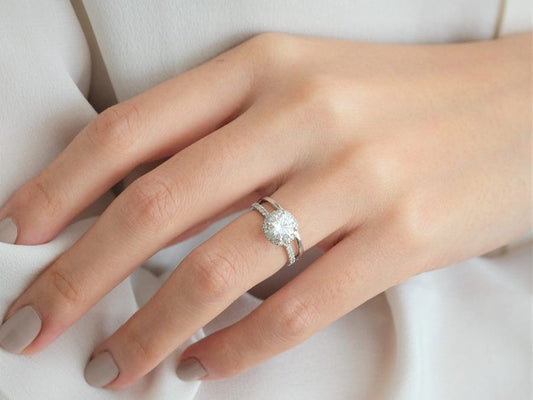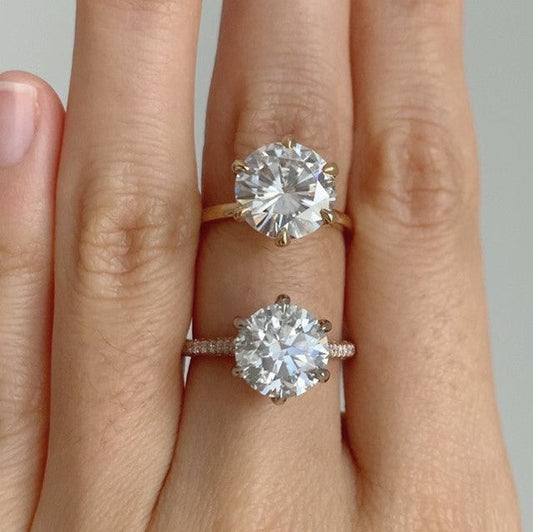Deciding between moissanite vs lab diamond stone for your engagement ring? You might be wondering if choosing lower-priced moissanite means giving something up, or if the differences even matter. It's easy to get confused when both stones look so stunning and promise ethical sourcing.
While moissanite and lab diamonds offer beautiful, conflict-free alternatives to mined diamonds, they're not the same. Today, we’re breaking down the real differences in lab grown diamonds vs moissanite, looking at appearance, durability, cost, resale value, and sustainability, so you can make the right choice for your relationship.
What is Moissanite?
First, to clear up one major difference between moissanite and lab diamond, moissanite isn't an artificial diamond. It's actually a completely different gemstone with its own unique properties.
Natural moissanite was first discovered in a meteorite, earning it the nickname "gemstone of the stars.” However, it's so rare in nature that virtually all moissanite used in jewelry today is lab-created. But unlike diamonds—natural or lab-grown—that are made of pure carbon, moissanite is made of silicon carbide. This different composition is what makes moissanite such a popular choice in engagement rings, giving it such a distinctive sparkle and fire that some people actually prefer to diamonds.
What is a Lab-Grown Diamond?
Lab-grown diamonds are chemically identical to natural diamonds. Both are pure carbon crystals formed under extreme pressure and heat. The only difference is that natural diamonds form deep in the earth over billions of years, while lab diamonds are created in controlled environments in a matter of weeks.
When it comes to quality, lab grown engagement rings aren't inferior to a natural diamond ring in any way. They have the same hardness, brilliance, and chemical composition. Even expert jewelers can't tell the difference without specialized equipment. So, when choosing a lab created diamond vs moissanite for your ring, you're getting a high-quality gemstone with different characteristics and price points.
Moissanite vs. Lab Grown Diamonds: What’s the Difference?
Is there any discernible difference when comparing a lab-grown diamond vs. moissanite? To the untrained eye, most people couldn’t tell the difference. However, the two are quite distinct, so telling the difference between lab grown diamond and moissanite is essential in making your purchasing decision.
Appearance and Sparkle
When wondering what’s the difference between moissanite and lab diamond, the most obvious answer is how they sparkle. Moissanite produces intense rainbow-like flashes of light, while lab diamonds give off a crisper, whiter sparkle. This happens because moissanite has a higher refractive index, meaning it bends light differently than diamonds do.
Another key difference is that moissanite is doubly refractive. When you look closely at a moissanite stone from certain angles, you might see the facets appear doubled or blurry. Diamonds are singly refractive, so their facets always appear sharp and clear.
Lab diamonds look identical to mined diamonds because they're the same material. But moissanite's extra fire and brilliance can actually work against it for some people. They find it looks "too sparkly" or even disco ball-like, especially in larger stones.
Ultimately, choosing between lab diamonds vs moissanite comes down to personal preference. Do you want the bold, colorful sparkle of moissanite, or the classic, elegant flash of a diamond? Neither choice is wrong. It's about what makes you smile when you look at your ring.
Hardness and Durability
Both moissanite and lab diamonds are incredibly durable choices for everyday wear. Lab diamonds score a perfect 10 on the Mohs hardness scale, making them the hardest material on earth. Moissanite comes in at 9.25 to 9.5, which is still harder than most other gemstones including sapphires and rubies.
What does this mean for your ring? Both stones resist scratches and chips exceptionally well. You can wear either one daily without worrying about damage from normal activities. The slight difference in hardness won't affect how your ring holds up over the years.
If we're splitting hairs, diamonds resist scratching slightly better due to their superior hardness. Moissanite, on the other hand, may actually resist breaking or chipping better because it's less brittle. But honestly, both stones are so durable that these differences rarely matter in real life. Your ring setting is more likely to need maintenance than the stone itself.
Cost Comparison
Moissanite typically costs a fraction of what you'd pay for a lab diamond of the same size. This price difference means you can get a larger or higher-quality moissanite stone for the same budget as a smaller lab diamond.
Lab diamond prices have dropped in recent years, but they still generally cost more than moissanite. The price gap remains significant enough that many couples notice the difference when shopping.
The choice between moissanite vs lab diamond often comes down to your priorities. If you want maximum visual impact for your budget, moissanite offers exceptional value. But if having a "real" diamond matters to you and you want that traditional diamond look at a lower price than mined stones, lab diamonds provide that option.
Certification and Grading Standards
A lab diamond comes with the same certifications as natural diamonds. Organizations like GIA and IGI grade them using the 4Cs (cut, color, clarity, and carat weight). This standardized grading system helps you understand exactly what you're buying and makes it easier to compare prices across different retailers.
Moissanite grading is much simpler. Most moissanite is only graded for color, typically ranging from colorless to near-colorless. You won't find detailed clarity or cut grades like you would with diamonds because moissanite is generally eye-clean and well-cut by default.
This difference in certification matters for resale value. Diamond grading reports provide trust and transparency that help maintain value in the secondary market. Without standardized grading, moissanite can be harder to resell, and buyers may be less confident about what they're getting. If future resale is important to you, lab diamonds have a clear advantage.
Sustainability and Ethical Sourcing
Both moissanite and lab diamonds are created in laboratories, eliminating the environmental damage and ethical concerns associated with diamond mining. No displaced communities, no massive mining pits, and no questionable labor practices.
The environmental impact depends largely on the manufacturer. Some lab diamond producers use renewable energy to power their facilities, while others rely on traditional power grids. The same goes for moissanite production. Energy-conscious brands like VRAI use zero-emission technology, but practices vary widely across the industry.
Also, while both stones are more ethical than mined diamonds by default, some companies go the extra mile to minimize their carbon footprint. Either way, you can feel good knowing your ring didn't contribute to the environmental and social costs of mining.
Lab Diamond vs Moissanite: Which Should You Choose?
There are a lot of similarities in moissanite vs lab diamond. They both bring outstanding brilliance, come in various cuts, and are conflict-free and eco-friendly. These gemstones will never leave you with a guilty conscience.
Moissanites surpass lab-grown diamonds in terms of sparkle and radiance. If you want a ring or necklace that catches the eye when you walk into any room, a moissanite piece is a great decision.
Although diamonds come with the bragging rights of owning a diamond, they’re still much more expensive. Moissanites cost a fraction of the price of both a mined diamond and a synthetic diamond.
Overall, it’s a matter of personal preference, but there are many reasons why moissanite has exploded in popularity.
Choose a Stone You Love at Gema&Co
Buying an affordable engagement ring doesn’t need hours of research. Let Gema&Co handle everything for you.
Browse our showcase for different cuts and styles. Alternatively, why not customize your own moissanite engagement ring from start to finish?
Find the ring you’ll fall in love with and shop with Gema&Co now.
--------------------------------------------------------------------
FAQ: Lab Grown Diamond vs Moissanite
Still deciding between lab-grown diamonds and moissanite? These quick answers can help you make the right choice for your engagement ring.
Are lab diamonds or moissanite better?
Neither lab diamonds nor moissanite are "better" than the other. It just depends on your priorities. If you want a real diamond, choose lab-grown; if you want more sparkle for less money, choose moissanite.
Is moissanite a fake diamond?
Moissanite is not a fake diamond—it's a completely different gemstone made of silicon carbide. It has its own unique properties and isn't trying to be a diamond.
What is the downside of moissanite?
The downsides of moissanite include its rainbow-like sparkle that some find too flashy and lower resale value. It also lacks the standardized grading certificates that diamonds have.




